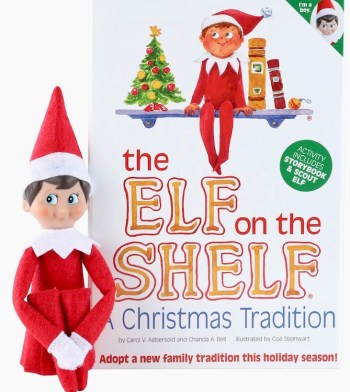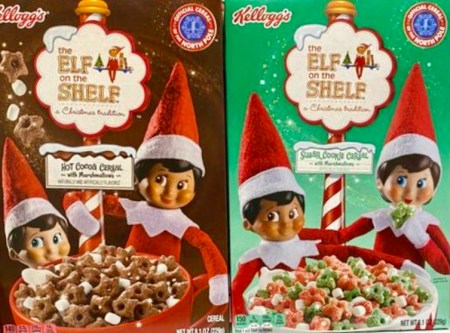Two especially satisfying examples of the elfshelfism, a riddle form presented visually:
(#1) Image: a cute furry mammal clinging to a bone. Punchline: lemur on a femur. (note: like elf and shelf, lemur and femur are (perfect) rhymes; unlike elf and shelf, however, they’re rare and remarkable nouns)
(#2) Image: a buxom woman reclining provocatively on a pile of Mexican food. Punchline: Dolly [Parton] on a tamale. (note: for most American speakers, Dolly and tamale are perfect rhymes, but for a substantial minority of American speakers, and for many others, they’re half-rhymes)
As with cartoons, getting the joke — here, solving the riddle — depends on bringing various kinds of cultural knowledge to bear on recognizing the crucial elements of the image. You need to recognize femurs, lemurs, Dolly Parton, and tamales; it’s not enough to know that femur, lemur, Dolly, and tamale are English nouns, you need to recognize images of their referents.
As with rhymed poetry, you also need to be prepared for the subtlety of half-rhyming rather than perfect rhymes.
I’ve been collecting clever instances of the form for a while (examples are endless; I’ll list a very small sample of these below). And then, posted by lolPhonology on Facebook on 12/21, came a lovely example exploiting the arcane technical terminology of linguistics:
You’ve heard of elf on the shelf, now get ready for …
(#3) Image: Four birds with letters on their bodies. Punchline: sonorants on cormorants (where sonorant refers to a symbol, in a system of phonetic transcription, for a sonorant, in most contexts for a sonorant consonant) (note: sonorant and cormorant are half-rhymes for everybody, though the details are different in different dialects)
From NOAD:
sonorant: Phonetics a sound produced with the vocal cords so positioned that spontaneous voicing is possible; a vowel, a glide, or a liquid or nasal consonant. [w is the symbol for a glide, r the symbol for a liquid, n and m symbols for nasal consonants]
I told you it was arcane. Plus, you have to recognize those birds as cormorants. And appreciate the half-rhyme. Whew!
Putting it all together. An elfshelfism is a riddle form with three components:
— an essentially fixed setup:
You’ve heard of elf on the shelf, now get ready for …
(with minor variations allowed)
— a riddle picture, a drawing or photo
— the punchline, of the form
N1 on a N2 (where the nouns N1 and N2 rhyme), as in the model elf on a shelf
(again, with minor variarions allowed)
Your task, as riddle-solver, is to find two elements in the riddle picture such that one element can be said to be on the other and the two elements have rhyming names (N1 and N2) in English, with the result that the picture can be described as N1 on a N2. Punchline!
(Elfshelfism is popularly referred to as a meme, which isn’t wrong — because elfshelfisms are widely disseminated cultural forms — but also isn’t especially informative.)
Some other examples. A vast numbers of pairs of rhyming nouns can be turned into elfshelfisms. Some of the results are routine and unsurprising — duck on a truck, boy on a toy, dog on a log — while others provide the pleasure of surprising juxtaposition — Santa on a Fanta, yeti on spaghetti, sloth on a Goth, Lego on an Eggo. A huge number require that you recognize some depicted personage on sight: Drake on a cake is a surprising juxtaposition (because it’s a guy sitting on a cake), but you won’t get it if you don’t recognize the rapper / singer Drake. Similarly:
Gollum on a column, Snape on a grape, Mr. Bean on the Queen, Bernie [Sanders] on a gurney, Snoop [Dogg] on the stoop, Rocky [the boxer] on a jockey
The model elf on a shelf. From Wikipedia:
The Elf on the Shelf: A Christmas Tradition is a 2005 American picture book for children, written by Carol Aebersold and her daughter Chanda Bell and illustrated by Coë Steinwart. The book tells a Christmas-themed story, written in rhyme, that explains how Santa Claus knows who is naughty and nice.
… The Elf on the Shelf comes in a keepsake box that features a hardbound picture book and a small scout elf.
(#4) The book and its accompanying scout elf… The book tells the story of a scout elf who hides in people’s homes to watch over events. Once everyone goes to bed, the scout elf flies back to the North Pole to report to Santa the activities, good and bad, that have taken place throughout the day. Before the family wakes up each morning, the scout elf flies back from the North Pole and hides. By hiding in a new spot around the house each morning, the scout elf plays an ongoing game of hide and seek with the family.
The book incites a variety of passions. Some people find it sweet and adorable (as its makers intended), others — me, for one — find the idea of a toy that informs to the authorities, Stasi-style, on the activities of its owner to be deeply creepy.
In any case, the toy comes with cloying associations that inspire people to lash out. So there’s a memic strain of scout elves posed doing nasty, gross, and raunchy things. And a memic strain of scout elves posed having dreadful — painful, disfiguring, and humiiating — things done to them. The lives of scout elves are indeed rich and eventful.
But wait! There’s more! Just this morning Aric Olnes reported on Facebook about the Kellogg company marketing Elf on the Shelf cereals — hot cocoa and sugar cookie flavors, both with marshmallows — promoted by smirking scout elves that scream, in effect, EAT ME!:
(#5) Sugar-buzz time in ShelfElfLand; note that the scouts now come in male pairs (oh, those libertine lads!)
Now, of course, we can look forward to cereal-based elfshelfisms. For example, in a picture of a box of one of these cereals atop a slag heap: cereal on waste material. Other rhymes for cereal that might be exploited: bacterial, ethereal, funereal, imperial, and yes, venereal.





December 22, 2022 at 10:21 am |
1. This is where I have learned the origin of elves on shelves, which I have seen popping up the past few winters, so thank you.
2. I never realized until today, looking at the cereal boxes and then reviewing the entire post, that the elf is on the shelf, not on _a_ shelf. (That definite quality seems not to be present in the elfshelfisms.)
December 23, 2022 at 12:53 am |
Also creepy, as an example of the Mandela effect: “Elf on a Shelf” turned into “The Elf on the Shelf” when nobody was looking.
December 23, 2022 at 4:39 am
For readers, on the Mandela effect, from the Wikipedia entry on false memory:
https://en.wikipedia.org/wiki/False_memory
December 23, 2022 at 9:10 am
Inasmuch as the book shown in #4 is the source of this meme, it appears that “Elf on _the_ shelf” was first, later morphing into “Elf on _a_ shelf” — and all the elfshelfisms that came also used _a_.
December 24, 2022 at 2:11 pm |
Another entry in the arcane elfshelfism stakes, from the Student Musical Organizer site (crediting Georgia State University Choirs) on 12/20: